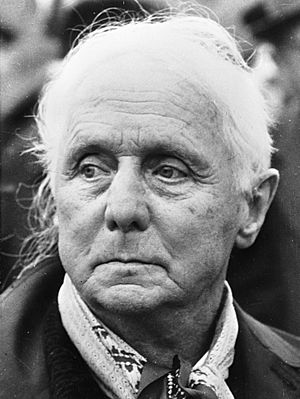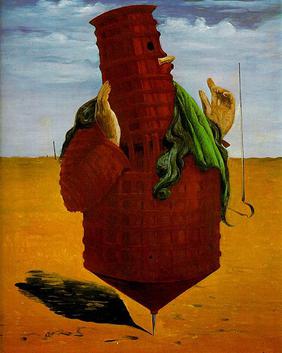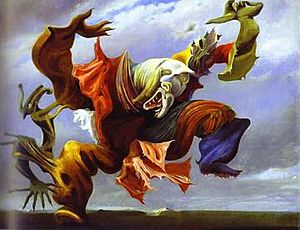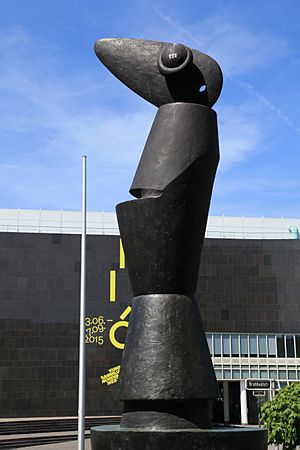Max Ernst facts for kids
Quick facts for kids
Max Ernst
|
|
|---|---|

Max Ernst in 1968
|
|
| Born |
Maximilian Maria Ernst
2 April 1891 Brühl, German Empire
|
| Died | 1 April 1976 (aged 84) Paris, France
|
| Nationality | German-American-French |
| Known for | Painting, sculpture, poetry |
|
Notable work
|
A Week of Kindness (1934) |
| Movement | Dada, Surrealism |
| Spouse(s) |
Luise Straus
(m. 1918–1927)Marie-Berthe Aurenche
(m. 1927–1942) |
Max Ernst (born April 2, 1891 – died April 1, 1976) was a famous German artist. He was a painter, sculptor, printmaker, graphic artist, and poet. Max Ernst was a key figure in starting the Dada and Surrealism art movements in Europe.
He didn't go to art school. Instead, he experimented a lot with art. He invented techniques like frottage, which uses pencil rubbings of textures to create images. He also created grattage, where paint is scraped off a canvas to show patterns from objects underneath. Ernst was also known for his unique drawing styles and for making novels using collages.
Max Ernst fought in World War I for four years. This experience deeply affected him. During World War II, he was living in France and was seen as an "undesirable foreigner." He passed away in Paris in 1976.
Max Ernst's Life Story
Growing Up and Early Art
Max Ernst was born in Brühl, Germany, near Cologne. He was the third of nine children in a middle-class family. His father, Philipp, was a teacher and an amateur painter. He taught Max to question authority and also sparked his interest in art.
In 1909, Max went to the University of Bonn. He studied many subjects, including philosophy and art history. He also started painting that year, drawing landscapes and portraits. In 1911, he met artist August Macke and decided to become an artist himself.
In 1912, he saw an exhibition with works by Pablo Picasso and Vincent van Gogh. These artists greatly influenced him. His own work was shown in galleries that same year. His early paintings often mixed strange elements with Cubism and German Expressionism styles.
In 1914, Ernst met Hans Arp, and they became close friends. Soon after, World War I began, and Ernst was drafted into the army. He fought on both the Western and Eastern Fronts. The war had a terrible impact on him. He later wrote that the person he was before the war "died" on August 1, 1914, and was "resurrected" after the war ended in 1918. While in the army, he sometimes charted maps, which allowed him to keep painting.
Dada and Surrealism Movements

After the war, in 1918, Ernst returned home and married Luise Straus. In 1919, he visited Paul Klee and studied paintings by Giorgio de Chirico. Inspired by de Chirico, Ernst started making his first collages. This technique became very important in his art.
Also in 1919, Ernst helped start the Cologne Dada group. Dada was an art movement that challenged traditional art and ideas. Ernst and his friends published magazines and organized Dada art shows.
Max and Luise's son, Jimmy Ernst, was born in 1920. He also became a painter. In 1921, Max Ernst met Paul Éluard, a poet who became a lifelong friend. Éluard bought some of Ernst's paintings and used his collages to illustrate his poetry.
In 1922, Ernst moved to France without proper papers and lived with Éluard and his wife in a Paris suburb. He worked odd jobs and continued to paint. In 1923, his art was shown in a big exhibition called Salon des Indépendants.
In 1925, Ernst invented frottage, a technique where he would place paper over a textured surface and rub a pencil over it to create an image. He also developed grattage, which involves scraping paint off a canvas to reveal patterns from objects placed underneath. He used grattage in his famous painting Forest and Dove. He also explored decalcomania, where paint is pressed between two surfaces.
Ernst was fascinated by birds, and they often appeared in his art. He even had an alter ego, a bird named Loplop. He believed this bird character came from a childhood memory. One night, his pet bird died, and soon after, his sister was born. Loplop often appeared in his collages.
In 1927, Ernst married Marie-Berthe Aurenche. He even appeared in a 1930 Surrealist film called L'Âge d'Or. In 1934, he started making sculptures. In 1938, Peggy Guggenheim, an American art collector, bought many of his works. Ernst and Peggy Guggenheim were married from 1942 to 1946.
World War II and Later Years
When World War II started in September 1939, Ernst was held in a camp in France. He was considered an "undesirable foreigner." He had been living with artist Leonora Carrington. Thanks to friends, he was released a few weeks later. But after Germany occupied France, he was arrested again. He managed to escape and flee to America with the help of Peggy Guggenheim.
Ernst and Peggy Guggenheim arrived in the United States in 1941 and married later that year. In New York City, he joined other artists who had escaped the war, like Marcel Duchamp. They helped inspire a new art style called Abstract expressionism.
His marriage to Guggenheim ended. In 1946, in California, he married American Surrealist painter Dorothea Tanning. They lived in Sedona, Arizona, from 1946 to 1953. The desert landscape there inspired his art. Ernst even built a small cottage with his own hands. Many artists and thinkers visited them there. Sedona became an important place for artists. While in Sedona, Ernst wrote his book Beyond Painting and finished his sculpture Capricorn.
From the 1950s, he mostly lived in France. In 1954, he won a major award for painting at the Venice Biennale. Max Ernst died in Paris on April 1, 1976, and was buried in Père Lachaise Cemetery.
Max Ernst's Legacy
Max Ernst's son, Jimmy Ernst, also became a well-known abstract expressionist painter. He passed away in 1984. Max Ernst's grandchildren, Eric and Amy, are also artists and writers.
A documentary film about Max Ernst, called Max Ernst, was made in 1991. It included interviews with Ernst, photos of his art, and memories from his wife Dorothea Tanning and son Jimmy.
The Max Ernst Museum opened in 2005 in his hometown of Brühl, Germany. It shows art from 70 years of his career. This includes paintings, drawings, collages, sculptures, and many documents and photos. The museum has works that Ernst himself donated to his hometown. It also displays works given by him to his fourth wife, Dorothea Tanning.
The Menil Collection in Houston, Texas, also has a large collection of Surrealist art, including over 100 pieces by Max Ernst. Some famous paintings there are In Praise of Freedom (1926) and The Marriage of Heaven and Earth (1964).
Exhibitions and Awards
Max Ernst's art has been shown in many important exhibitions around the world:
- He received the Grand Prize for Painting at the Venice Biennale in 1954.
- He was awarded the Grand Prix national des arts in Paris in 1959.
- His work was shown at the Museum of Modern Art in New York (1961) and the Tate Gallery in London (1962).
- A large exhibition of 104 of his works traveled across Europe and the US from 1970 to 1972.
- In 2005, "Max Ernst: A Retrospective" opened at the Metropolitan Museum of Art. This show included famous works like Celebes (1921) and Fireside Angel (1937). The exhibition also highlighted his experimental techniques like frottage, grattage, and decalcomania.
Selected Works
Early Work, Germany (1891–1922)
- Crucifixion (1913), Wallraf-Richartz Museum, Cologne
- Town with Animals or Landscape (c. 1916), Solomon Guggenheim Museum, New York
- Aquis Submersus (1919), Städel, Frankfurt
- Fiat modes (1919), a series of eight lithographs
- Trophy, Hypertrophied (1919), Museum of Modern Art, New York
- Little Machine Constructed by Minimax Dadamax in Person (1919–1920), Peggy Guggenheim Collection
- He's Not Very Well, the Hairy-hoofed Horse (1920) Turin Civic Gallery
- Dada Gauguin (1920), The Art Institute of Chicago
- Murdering Airplane (1920), Menil Collection, Houston
- The Hat Makes the Man (1920), Museum of Modern Art, New York
- The Elephant of the Celebes (1921), Tate Modern, London
- Oedipus Rex (1922), Private Collection
First French Period (1922–1940)
- All Friends Together (1922), Wallraf-Richartz Museum, Cologne
- Pietà or Revolution by Night (1923), Tate Modern, London
- The Wavering Woman (1923), Kunstsammlung Nordrhein-Westfalen, Düsseldorf
- Saint Cecilia (1923), Staatsgalerie, Stuttgart
- Of This Men Shall Know Nothing (1923), Tate Modern, London
- Ubu Imperator (1923), Musée National d'Art Moderne, Paris
- Two Children Are Threatened by a Nightingale (1924), Museum of Modern Art, New York
- Woman, Old Man and Flower (1924), Museum of Modern Art, New York
- Paris Dream (1924–25), Yale University Art Gallery, New Haven
- The Blessed Virgin Chastises the Infant Jesus (1926), Museum Ludwig, Cologne
- The Great Forest (1927), Kunstmuseum, Basel
- Forest and Dove (1927), Tate Modern, London
- The Wood (1927), National Museum Cardiff, Cardiff
- Shell Flowers (1929), Musée National d'Art Moderne, Paris
- Inside Sight: the Egg (1929), Menil Collection, Houston
- Loplop Introduces Loplop (1930), Menil Collection, Houston
- Loplop Introduces a Young Girl (1930), Musée National d'Art Moderne, Paris
- Oedipus I and II (both 1934), bronze sculpture
- Lunar Asparagus (1935), plaster sculpture, Museum of Modern Art, New York
- Garden Plane Trap (1934–35), Philadelphia Museum of Art, Philadelphia
- The Giant Snake (1935).
- The Entire City (1935–36), Kunsthaus, Zürich
- The Blind Swimmer, Effect of Touch (1934), Museum of Modern Art, New York
- The Joy of Living (1936), Scottish National Gallery of Modern Art, Edinburg
- The Nymph Echo (1936), Museum of Modern Art, New York
- The Angel of Hearth and Home (1937), Neue Pinakothek, Munich
- The Barbarians (1937), Metropolitan Museum of Art, New York
- The Fascinating Cypress (1940), Sprengel Museum, Hanover
- The Robing of the Bride (1940), Peggy Guggenheim Collection, Venice
American Period (1941–1952)
- Totem and Taboo (1941), Private collection
- Marlene (1941), Menil Collection, Houston
- Napoleon in the Wilderness (1941), Museum of Modern Art, New York
- Day and Night (1941–42), Menil Collection, Houston
- The Antipope (1942), Peggy Guggenheim Collection, Venice
- Europe After the Rain II (1940–42), Wadsworth Athenaeum, Hartford
- Surrealism and Painting (1942), Menil Collection, Houston
- The Bewildered Planet (1942), Tel Aviv Museum of Art, Tel-Aviv
- Vox Angelica (1943), Private collection
- Everyone Here Speaks Latin (1943), New Orleans Museum of Art, New Orleans
- Painting for Young People (1943), Menil Collection, Houston
- Moonmad (1944), bronze sculpture
- An Anxious Friend (1944), bronze sculpture
- The Eye of Silence (1944), Washington University Gallery of Art, St. Louis
- The Temptation of Saint Anthony (1945), Lehmbruck Museum, Duisburg
- The Phases of the Night (1946), Private collection
- Dream and Revolution (1947), Private collection
- Design in Nature (1947), Menil Collection, Houston
- Capricorn (1948), bronze sculpture
- A Beautiful Day (1948)
- Feast of the Gods (1948), Mumok, Vienna
- Paramythes (1949), collages with poems
- Inspired Hill (1950), Menil Collection, Houston
- Spring in Paris (1950), Wallraf-Richartz Museum, Cologne
Second French Period (1953–1976)
- Colorado of Medusa, Color-Raft of Medusa (1953), Private collection
- Cry of the Gull (1953), Menil Collection, Houston
- Father Rhine (1953), Kunstmuseum, Basel
- The King Playing with the Queen (1954), bronze sculpture
- The Twentieth Century (1955), Menil Collection, Houston
- Bird-head (1955–56), bronze sculpture
- The Dark Gods (1957), Museum Folkwang, Essen
- Albertus Magnus (1957), Menil Collection, Houston
- After Me Comes Sleep: Tomb of the Poet (1958), Musée National d'Art Moderne, Paris
- Little Girls out to Hunt the White Butterflies (1958), Thyssen-Bornemisza Museum, Madrid
- Mundus est fabula (1959), Museum of Modern Art, New York
- The Garden of France (1962), Musée National d'Art Moderne, Paris
- Serenity (1963), Menil Collection, Houston
- The Marriage of Heaven and Earth (1964), Menil Collection, Houston
- The World of the Naive (1965), Private collection
- Ubu, Father and Son (1966), Private collection
- Teaching Staff for a School of Murderers (1967), bronze sculptures
- Birth of a Galaxy (1969), Beyeler Foundation, Riehen
- The Last Forest (1960–1970), Private collection
- The Night Prowling Fish (1974), Private collection
Prints, Collages, and Illustrations
- Illustrations for books by Paul Éluard: Répétitions (1922), Les malheurs des immortels (1922), Au défaut du silence (1925)
- Histoire Naturelle (ca. 1925–1926), a set of 34 collotypes after frottages
- La femme 100 têtes (1929, graphic novel)
- Rêve d'une petite fille qui voulut entrer au carmel (1930, graphic novel)
- Une Semaine de Bonté (1934, graphic novel)
- Illustrations for books by Lewis Carroll: Symbolic Logic (1966), The Hunting of the Snark (1968), and Lewis Carrols Wunderhorn (1970)
- Deux Oiseaux (1970, lithograph in colours)
- Aux petits agneaux (1971, lithographs)
- Paysage marin avec capucin (1972, illustrated book)
- Maximiliana: the illegal practice of astronomy : hommage à Dorothea Tanning (1974, art book)
- Oiseaux en péril (1975, etchings with aquatint in colours; published after his death)
Images for kids
-
Opening of the Max Ernst exhibition in Paris, May 2, 1921. From left: René Hilsum, Benjamin Péret, Serge Charchoune, Philippe Soupault (top of the ladder), Jacques Rigaut (upside down), André Breton and Simone Kahn-Breton.
-
Cover of Répétitions (1922) by Paul Éluard, with illustrations by Max Ernst.
See also
 In Spanish: Max Ernst para niños
In Spanish: Max Ernst para niños








